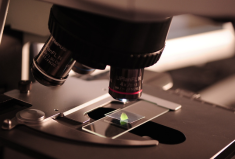
How we test
Testing for microplastics is a fascinating and complex field and the appropriate method will depend on the purpose of the test and the material (water, sludge, cosmetic products, etc.) to be tested.
Eurofins Environment Testing laboratories are committed to staying at the forefront of the development of new methods in order to assist our customers across the globe to monitor all “compounds” of concern, including microplastics, for the benefit of our societies.
Microplastics (plastic particles <5 mm) do not biodegrade in the environment and are an emerging topic of concern. Laboratories across the global Eurofins Environment Testing network test for microplastics and carry out data collection to support stakeholders to make informed decisions related to these potentially harmful contaminants.
Microplastics is still a new field of study, with several different measurement methods and techniques currently being developed. These methods have different strengths and weaknesses. To determine the best method, please contact a Eurofins Environment Testing microplastics laboratory to find the best solution from the wide range of testing and identification options.
What are microplastics and why should you care?
Plastics have become an integral part of daily lives, used in many products for their incredible versatility. By 2017 humans had produced over 9.2 billion tons of plastic since 1950, and this number continues to rise rapidly.
Management of plastic waste has fallen behind, leading to significant accumulation in the environment. Due to its remarkable durability, plastic gradually breaks down into smaller particles called microplastics through weathering and disintegration, which can ultimately end up in our oceans and streams.
Primary microplastics can also be intentionally added to a range of products, from fertilisers, cosmetics, and common household products to industrial strength detergents, cleaning products, paints, plant protection products, and products used by the oil and gas industry. Microplastics are also known to be released from the beads used in artificial turf fields. The European Chemicals Agency (ECHA) states that the European Union/European Economic Area alone uses 145,000 tons of intentionally added microplastic are used per year (ECHA, 2021). In September 2023, the European Commission adopted measures that restrict microplastics that are intentionally added to products under the EU Registration, Evaluation, Authorization and Restriction of Chemicals (REACH) legislation. The new rules will prevent the release of about half a million tons of microplastics over 20 years to the environment.
Microplastics have been found both in marine and freshwater as well as in the terrestrial ecosystem. Unfortunately, once microplastics enter the environment, they accumulate in animals, ultimately finding their way back to humans through food and drinking water.
The effects of microplastics are still being researched, but it is known that they negatively impact our ecosystem, water quality and even human health, not only because of their physical properties, but through related chemical and biological risks, such as accumulation of toxic chemicals and the transport of pathogens.
Matrices we can test
Who we support


Testing for microplastics is a fascinating and complex field and the appropriate method will depend on the purpose of the test and the material (water, sludge, cosmetic products, etc.) to be tested.

Before the sample is analysed on the instrument, it needs to undergo some form of sample preparation or clean-up. The goal of this preparation is to isolate the microplastic, separate it from any interfering compounds in the sample, and make it compatible with the desired measurement technique. The specific process varies between techniques and sample types.

Eurofins Environment Testing laboratories’ state-of-the-art microplastic analysis methods provide qualitative results to identify the different polymer types in the samples. Furthermore, the number of microplastics is quantified using spectroscopy (Raman, FTIR and LDIR), and total mass of particles reported, using thermoanalytical methods (TD-GC/MS and Pyrolysis-GC/MS).
See below for some of the most common measurement techniques used to test for microplastics:

| Method | Information obtained | Provided by Eurofins | |
| Microscopy | Light Microscopy | Number, Size, Morphology, Color | yes |
| Fluorescence Microscopy | |||
| Scanning Electron Microscopy | |||
| Atomic Force Microscopy | |||
| Spectroscopy |
Raman Spectroscopy | Type in the size range 1-20 um | yes |
| Fourier Transformation Infrared Spectroscopy (FTIR) | Type in the size range 25-5,000 um | yes | |
| Laser Direct Infrared Imaging (LDIR) with Attenuated Total Reflectance (ATR) | Type in the size range 20-5,000 um | yes | |
| Thermal Analysis | Pyroysis (PYR) GC-MS | Type as Concentration | yes |
| Thermal Desorption (TD) GC-MS | yes |

Please reach out to one of our global specialists to find out more about Microplastics Testing in your Region.

Eurofins Environment Testing Bergen | Sandviksveien 110, Bergen, NO-5035, Norway | Tel:+47 94 50 42 42, Fax:+47 55 54 92 80, bergen@etn.eurofins.com
Eurofins IPROMA | Av. de Los Pirineos nº 9 - Nave17, 28703, S.S. de los Reyes (MADRID), Spain | Tel:+34 916 587 440, atencioncliente@iproma.com
Eurofins Analytical Services Hungary Kft. | Anonymus u. 6, Budapest 1045, Hungary | Tel:+3618723600, kornyezet@laboratorium.hu
Eurofins Environment Testing Australia Pty Ltd. | 6 Monterey Road, VIC 3175, Dandenong South Australia | Phone: +61 3 8564 5000, MicroPlasticsAUS@eurofinsanz.com
Eurofins Environment Testing - Sacramento | 880 Riverside Parkway, West Sacramento, CA 95605 | Phone: 916-373-5600, Env.Marketing@ET.EurofinsUS.com
Eurofins Consumer Product Testing Vietnam | 1/4 Tan Thoi Nhat 18 Street, Tan Thoi Nhat Ward, District 12, Ho Chi Minh City, Vietnam | Phone: +84 28 7109 8828, Email: CPTVNcs@cpt.eurofinsasia.com
